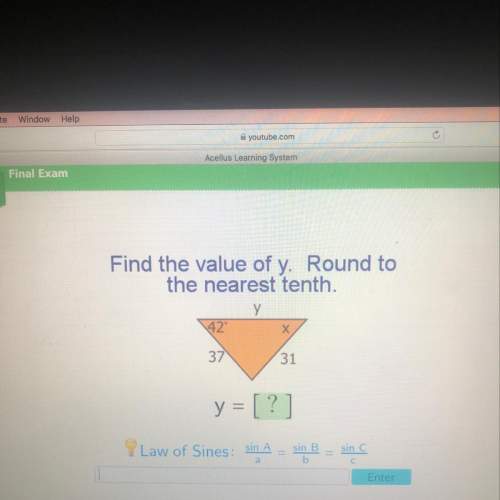
Mathematics, 01.07.2020 15:01 chaofails
Use reduction of order (NOT the integral formula we developed) to find the general solution of the nonhomogeneous linear DE, showing all work. Also clearly state the particular solution yp that you obtain using the reduction of order process and show a clear check that your particular solution yp satisfies the original nonhomogeneous DE. [Do NOT use the Method of Undetermined Coefficients here!]
''y + 6y' + 9y + 4e^x
Note: Use the characteristic polynomial to find a first solution yi of the associated homogencous DE.)

Answers: 1


Another question on Mathematics

Mathematics, 21.06.2019 17:10
How many lines can be drawn through points j and k? 0 1 2 3
Answers: 2

Mathematics, 21.06.2019 19:30
Consider this equation. |y + 6| = 2 what can be concluded of the equation? check all that apply. there will be one solution. there will be two solutions. the solution to –(y + 6) = 2 will be also be a solution to the given absolute value equation. the solution(s) will be the number(s) on the number line 2 units away from –6. the value of y must be positive since the variable is inside absolute value signs.
Answers: 1

Mathematics, 21.06.2019 22:20
Atriangle has verticals at b(-3,0), c(2,-1), d(-1,2). which transformation would produce an image with verticals b”(-2,1), c”(3,2), d”(0,-1)?
Answers: 2

Mathematics, 21.06.2019 23:00
How many heads would you expect if you flipped a coin twice? first, fill in the table below with the correct probabilities. hint: the sample space for flipping a coin twice is {hh, ht, th, tt}. a = b = c = f
Answers: 1
You know the right answer?
Use reduction of order (NOT the integral formula we developed) to find the general solution of the n...
Questions







Mathematics, 16.03.2020 21:30

Mathematics, 16.03.2020 21:30

Mathematics, 16.03.2020 21:30

Mathematics, 16.03.2020 21:30

Mathematics, 16.03.2020 21:30

Mathematics, 16.03.2020 21:30

History, 16.03.2020 21:30







 where A,B are constants.
where A,B are constants. . To find the homogeneus solution, we assume that
. To find the homogeneus solution, we assume that  and replace it in the equation
and replace it in the equation  . If we do so, after using some properties of derivatives and the properties of the exponential function we end up with the equation
. If we do so, after using some properties of derivatives and the properties of the exponential function we end up with the equation 
 , where c_1 is a constant.
, where c_1 is a constant.




 . Then we get the equation
. Then we get the equation


 where d is another constant.
where d is another constant.


